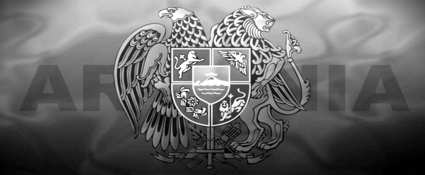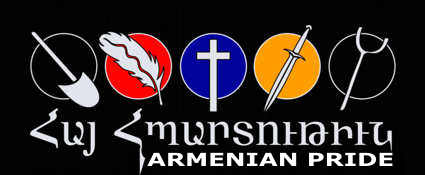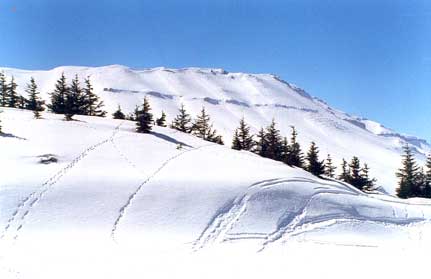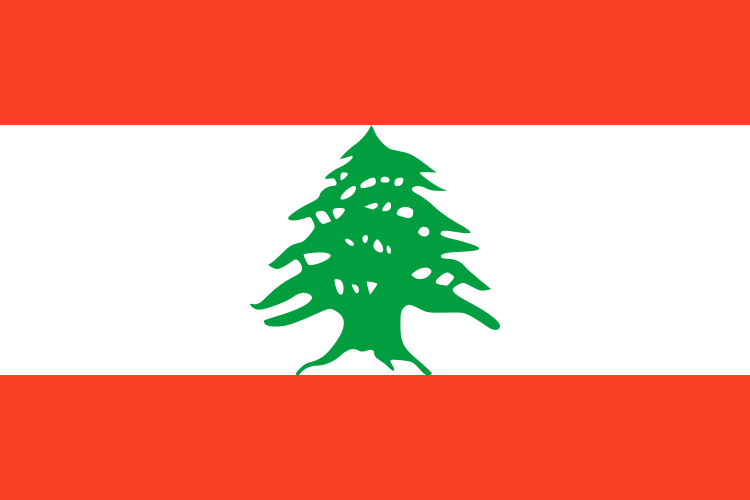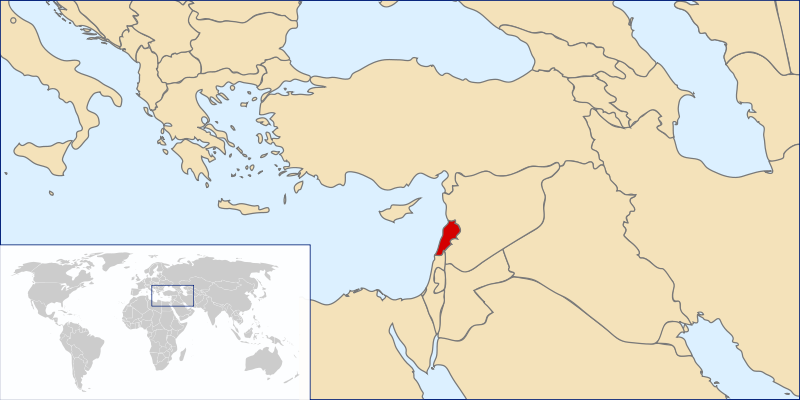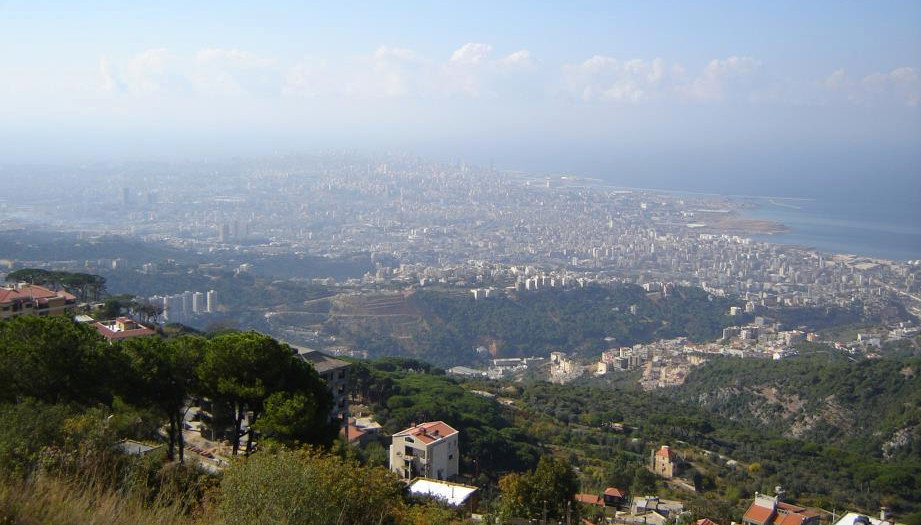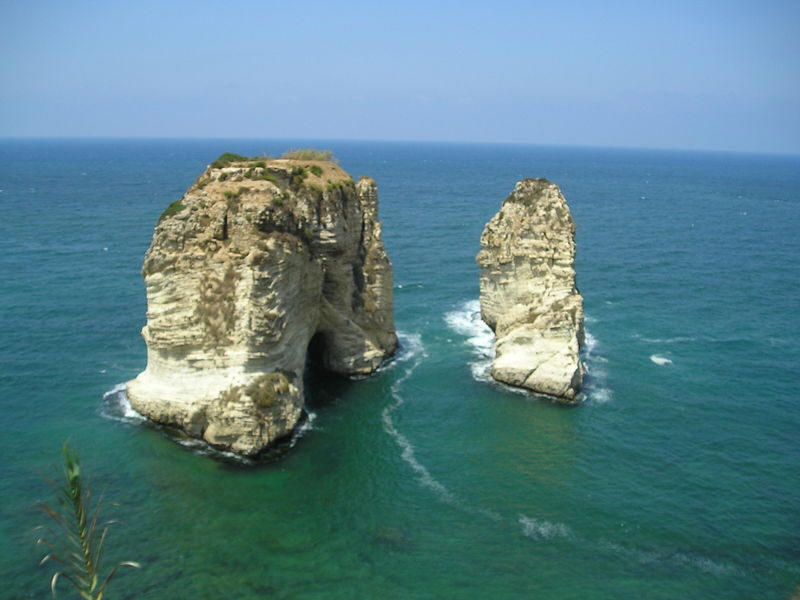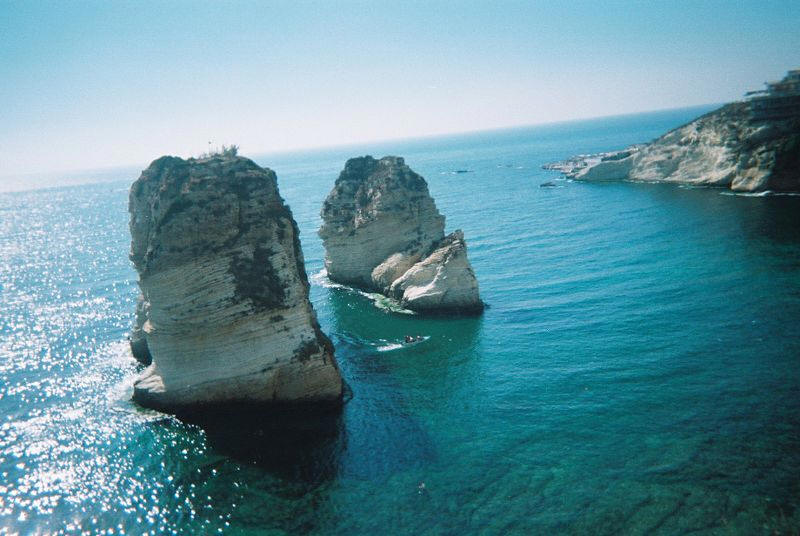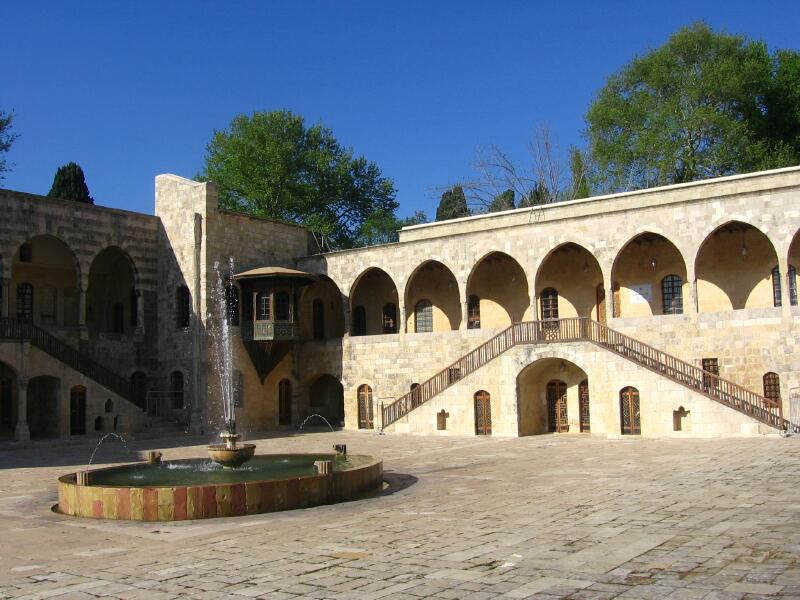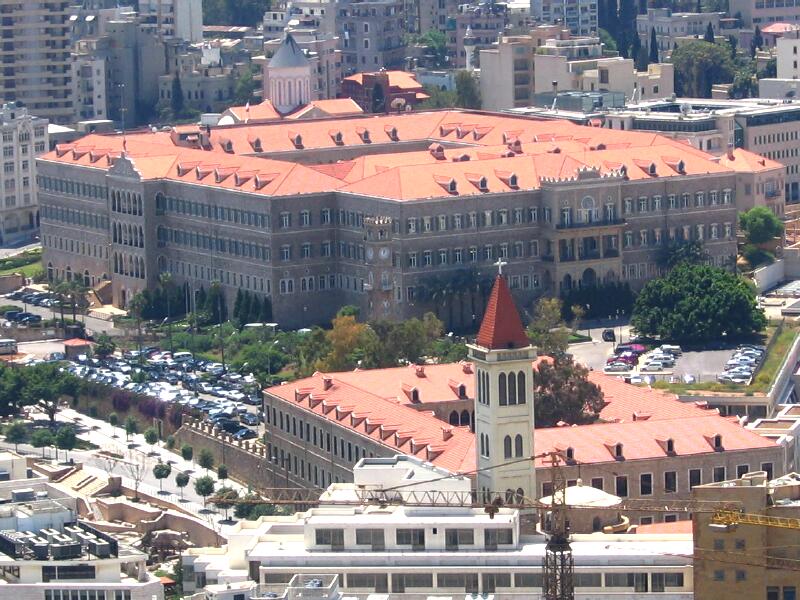|
Lebanon  الجمهورية اللبنانية
الجمهورية اللبنانية
Lebanon(Arabic:
لبنان
Lubnān; French:
Liban),officially the
Republic of Lebanon
or Lebanese Republic (الجمهورية
اللبنانية), La République
Libanaise, is a small, predominantly
mountainous country in Western Asia,
on the eastern shore of the
Mediterranean Sea. It is bordered by
Syria to the north and east, and
Israel to the south. Due to its
sectarian diversity, Lebanon evolved
a peculiar political system, known
as confessionalism, based on a
community-based power-sharing
mechanism. It was created when the
ruling French mandatory powers
expanded the borders of the former
Maronite Christian autonomous
Ottoman Mount Lebanon district.
The flag of
Lebanon features a cedar in green
against a white backdrop, bounded by
two horizontal red stripes along the
top and bottom. This is a reference
to the famous cedars of Lebanon,
that were mentioned in the verses of
the Tanakh/Old Testament, mostly in
Psalms and the Song of Songs.
Until the
Lebanese Civil War (1975-1990), the
country enjoyed relative calm and
prosperity, driven by the tourism,
agriculture, and banking sectors of
the economy. It is considered the
banking capital of the Levant and
was widely known as the "Switzerland
of the Middle East" due to its
financial power. Lebanon also
attracted large numbers of tourists,
to the point that the capital Beirut
became widely referred to as the
"Paris of the Middle East."
Immediately
following the end of the war, there
were extensive efforts to revive the
economy and rebuild national
infrastructure. By early 2006, a
considerable degree of stability had
been achieved throughout much of the
country, Beirut's reconstruction was
almost complete, and an increasing
number of foreign tourists were
pouring into Lebanon's resorts.
Israeli air attacks during the 2006
war caused major damage to civilian
infrastructure from July 12, 2006
until a ceasefire went into effect
on August 14, 2006.
Etymolog
A widespread
explanation links the name Lebanon ("Lubnān"
in standard Arabic; "Lebnén" in local
dialect) to the Phoenician root "LBN",
which is linked to several
closely-related meanings in various
languages, such as "white" and "milk".
"White" could be regarded as reference
to the snow-capped Mount Lebanon.
Occurrences of the name have been found
in three of the twelve tablets of the
Epic of Gilgamesh (2900 BC), the texts
of the library of Ebla (2400 BC), and 71
times in the Old Testament. The name is
even recorded in Ancient Egyptian as
Rmnn, where r stood for
Phoenician.
Gove
Beirut
(Arabic:
بيروت
,
transliteration:
Bayrūt, Greek: Βηρυττός),
is the capital, largest city, and chief
seaport of Lebanon. It is usually
referred to by Lebanese people by its
French name, Beyrouth.
There are wide-ranging estimates of
Beirut's population, from as low as
938,940 people, to 1,303,129 people, to
as high as 2,012,000. The lack of an
exact figure is due to the fact that no
"comprehensive" population census has
been taken in Lebanon since 1932.
Beirut
had undergone major reconstruction in
recent years
and hosted the Francophonie and the Arab
League summits in 2002. In 2007, Beirut
hosted the ceremony for Le Prix Albert
Londres, which rewards outstanding
Francophone journalists every year. The
city is set to host the Jeux de la
Francophonie in 2009.
Beirut was
considered as a possible candidate for
the 2024 Summer Olympics games.The
massive $1.2 billion Sannine Zenith
project will make Lebanon capable of
holding the games.
The city is
home to numerous international
organizations. The United Nations
Economic and Social Commission for
Western Asia (ESCWA) is headquartered in
Downtown Beirut while the International
Labour Organization (ILO) and UNESCO
(United Nations Educational, Scientific
and Cultural Organization) both have
regional offices in Beirut covering the
Arab world. The Arab Air Carriers
Organization (AACO) is also
headquartered in Beirut.
In Travel and
Leisure magazine's World Best Awards
2006, Beirut was ranked the 9th (out of
10) city in the world, falling just
short of New York City and coming ahead
of San Francisco.
History
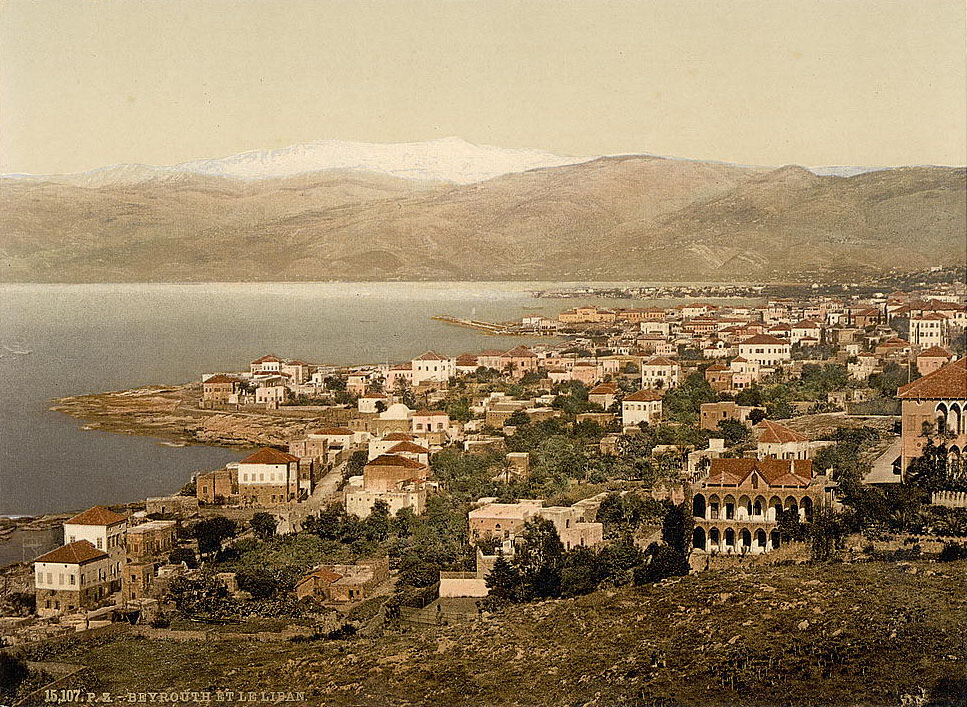 |
Originally named Bêrūt,
"The Wells" by the
Phoenicians,Beirut's history
goes back more than 5000
years.Excavations in the
downtown area have unearthed
layers of Phoenician,
Hellenistic, Roman, Arab and
Ottoman civilizations.
The first historical reference
to Beirut dates from the 14th
century BC, when it is mentioned
in the cuneiform tablets of the
"Amarna letters." Ammunira of
Biruta
(Beirut) sent 3 letters to the
pharaoh of Egypt.]
Biruta is also referenced in the
letters from Rib-Hadda of Byblos.
The most ancient settlement was
on an island in the river that
progressively silted up.
The city was known in antiquity
as
Berytus (see also List of
traditional Greek place names);
this name was taken in 1934 for
the archaeological journal
published by the Faculty of Arts
and Sciences at the American
University of Beirut. |
View
of Beirut with Snow-Capped Sannine
Summit of Mount Lebanon in the
Background - 19th century
Beirut
panorama overview
Beirut
overview
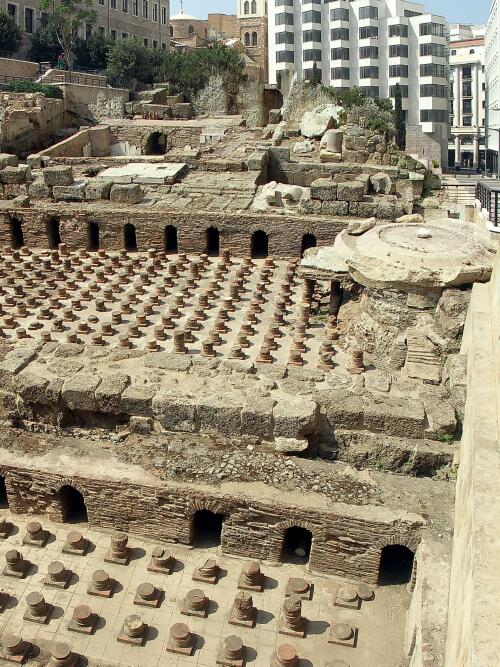 |
In 140 BC, the city was taken
and destroyed by
Diodotus Tryphon
in his contest with Antiochus
VII Sidetes for the throne of
the Seleucid monarchy. Beirut
was soon rebuilt on a more
regularized Hellenistic plan,
renamed Laodicea in Phoenicia
(Greek: Λαοδικεια ή του Φοινίκη)
or
Laodicea in Canaan, in honor
of a Seleucid Laodice. The
modern city overlies the ancient
one and little archaeology had
been accomplished until after
the end of the civil war in
1991; now large sites in the
devastated city center have been
opened to archaeological
exploration. A dig in 1994
established that one of Beirut's
modern streets, Souk Tawile,
still follows the lines of an
ancient Hellenistic/Roman one.
Mid-first century coins of
Berytus bear the head of Tyche,
goddess of fortune; on the
reverse, the city's symbol
appears: a dolphin entwines an
anchor. This symbol was taken up
by the early printer Aldus
Manutius in 15th century Venice.
Beirut was
conquered by Agrippa in 64 BC and the
city was renamed in honor of the
emperor's daughter, Julia; its full name
became Colonia Julia Augusta Felix
Berytus.
The veterans of two Roman legions were
established in the city: the fifth
Macedonian and the third Gallic.
The city quickly became Romanized. Large
public buildings and
monuments were erected and Berytus
enjoyed full status as a
part of the empire.
|
Roman baths in Downtown
Beirut
Under the
Romans, it was enriched by the dynasty
of Herod the Great, and was made a
colonia,
Colonia Iulia Augusta Felix Berytus,
in 14 BC. Beirut's school of law was
widely known at the time.Two of Rome's
most famous jurists, Papinian and Ulpian,
both natives of Phoenicia, taught at the
law school under the Severan emperors.
When Justinian assembled his
Pandects
in the 6th century, a large part of the
corpus of laws were derived from these
two jurists, and Justinian recognized
the school as one of the three official
law schools of the empire (533). Within
a few years, as the result of a
disastrous earthquake (551), the
students were transferred to Sidon.
About 30,000 were killed in Berytus
alone and, along the Phoenician coast,
total casualties were close to 250,000.
Beirut passed
to the Arabs in 635. As a trading centre
of the eastern Mediterranean, Beirut was
overshadowed by Akka during the Middle
Ages. From 1110 to 1291 it was in the
hands of the Crusaders. No matter who
was its nominal overlord, whether Turk
or Mamluk, Beirut was ruled locally by
Druze emirs. One of these, Fakr ed-Din
Maan II, fortified it early in the 17th
century, but the Ottomans retook it in
1763 and thenceforth, with the help of
Damascus, Beirut successfully broke
Akka's monopoly on Syrian maritime trade
and for a few years supplanted it as the
main trading centre in the region.
During the succeeding epoch of rebellion
against Ottoman hegemony at Akka under
Jezzar and Abdullah
pashas, Beirut declined to a small town
(population about 10,000), and was
fought over among the Druze, the Turks
and the pashas.
After
Ibrahim Pasha
captured Akka in 1832, Beirut began its
early modern revival. In 1888, Beirut
was made capital of a vilayet in Syria,
including the sanjaks Latakia, Tripoli,
Beirut, Akka and Bekaa. Beirut became a
very cosmopolitan city and had close
links with Europe and the United States.
Beirut became a centre of missionary
activity, which was generally very
unsuccessful in conversions (a massacre
of Christians in 1860 was the occasion
for further European interventions), but
did build an impressive education
system. This included the Syrian
Protestant College, which was
established by American missionaries and
eventually became the American
University of Beirut (AUB). Beirut
became the centre of Arab intellectual
activity in the 19th century. Provided
with water from a British company and
gas from a French one, the city thrived
on exporting silk grown on nearby Mount
Lebanon. After French engineers
established a modern harbor (1894) and a
rail link across Lebanon to Damascus,
and then to Aleppo (1907), much of the
trade was carried by French ships to
Marseille, and soon French influence in
the area exceeded that of any other
European power. In 1911, the population
mix was reported in the
Encyclopædia
Britannica
as Muslims, 36,000; Christians, 77,000;
Jews, 2500; Druze, 400; foreigners,
4100. After the collapse of the Ottoman
Empire following World War I, Beirut,
along with all of Lebanon was placed
under the French Mandate.
Lebanon
achieved independence in 1943 and Beirut
became its capital city. Beirut remained
the intellectual capital of the Arab
world and a major commercial and tourist
center until 1975 when a brutal civil
war broke out in Lebanon During most of
the war, the city was divided between
the largely Muslim west part and the
Christian east. The central area of the
city, previously the focus of much of
the commercial and cultural activities,
became a no man's land. Many of the
city's inhabitants fled to other
countries. In 1983, French and US
barracks were bombed, killing 302.[citation
needed]
Since the end
of the war in 1989, the people of
Lebanon have been rebuilding Beirut, and
by the start of the 2006 Israel-Lebanon
conflict the city had somewhat regained
its status as a tourist, cultural, and
intellectual center in the Middle East,
as well as a center for commerce,
fashion, and media. However, many would
say the city has lost its premier
status, due to competition from places
like Dubai and Cyprus in the fields of
tourism, business, fashion, commerce,
and banking.[citation
needed]
Reconstruction of downtown Beirut has
been largely driven by Solidere, a development company established in 1994
by Rafik Hariri. Beirut is home to the
international designer Elie Saab,
jeweller Robert Moawad, and to some
popular satellite television stations,
such as LBC, Future TV, New TV and
others. The city was host to the Asian
Basketball Championship and the Asian
Football Championship. Beirut also
successfully hosted the Miss Europe
pageant eight times, 1960-1964, 1999,
2001-2002.
The 2005
assassination of former Lebanese Prime
Minister Rafik Hariri near the Saint
George Bay in Beirut shook the entire
country. Approximately one million
people gathered for an opposition rally
in Beirut, a month after the death of
Hariri. The "Cedar Revolution" was the
largest rally in Lebanon's history. The
last Syrian troops withdrew from Beirut
on April 26, 2005.
French mandate
and independence
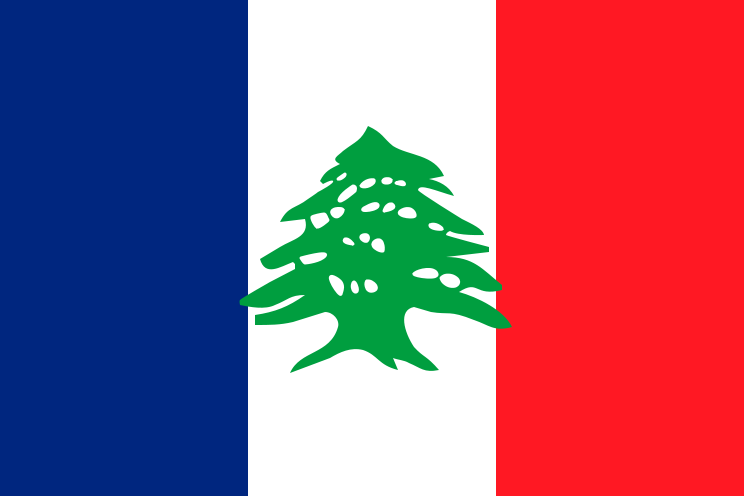 |
Lebanon was part of the Ottoman
Empire for over 400 years, in a
region known as Greater Syria,
until 1918 when the area became
a part of the French Mandate of
Syria following World War I. On
September 1, 1920, France formed
the State of Greater Lebanon as
one of several ethnic enclaves
within Syria. Lebanon was a
largely Christian (mainly
Maronite) enclave but also
included areas containing many
Muslims and Druzes. On September
1, 1926, France formed the
Lebanese Republic. The Republic
was afterward a separate entity
from Syria but still
administered under the French
Mandate of Syria. Lebanon gained
independence in 1943, while
France was occupied by Germany.
General Henri Dentz, the Vichy
High Commissioner for Syria and
Lebanon, played a major role in
the independence of the nation.
The Vichy authorities in 1941
allowed Germany to move aircraft
and supplies through Syria to
Iraq where they were used
against British forces. The
United Kingdom, fearing that
Nazi Germany would gain full
control of Lebanon and Syria by
pressure on the weak Vichy
government, sent its army into
Syria and Lebanon. |
The flag of
Greater
Lebanon (1920-1943)
After the
fighting ended in Lebanon, General
Charles de Gaulle visited the area.
Under various political pressures from
both inside and outside Lebanon, de
Gaulle decided to recognize the
independence of Lebanon. On November 26,
1941 General Georges Catroux announced
that Lebanon would become independent
under the authority of the Free French
government. Elections were held in 1943
and on November 8, 1943 the new Lebanese
government unilaterally abolished the
mandate. The French reacted by throwing
the new government into prison. In the
face of international pressure, the
French released the government officials
on November 22, 1943 and accepted the
independence of Lebanon.
The allies kept
the region under control until the end
of World War II. The last French troops
withdrew in 1946. Lebanon's unwritten
National Pact of 1943 required that its
president be Christian and its prime
minister be Muslim.
Lebanon's
history since independence has been
marked by alternating periods of
political stability and turmoil
(including a civil conflict in 1958)
interspersed with prosperity built on
Beirut's
position as a regional center for
finance and trade.
The
Armenians in Lebanon
The
Armenians in Lebanon
are Lebanese citizens of Armenian
descent. There has been an Armenian
presence in Lebanon for centuries. While
there has not been a census for a few
decades, because the balance between
Christians and Muslims is considered to
be a volatile subject, it is estimated
that there are approximately 150,000
Armenians in Lebanon, or around 4% of
the population.* Prior to the Lebanese
Civil War, the number was higher.
Lebanese-Armenians are guaranteed 6
seats in the Lebanese parliament: 5 for
Armenian Orthodox, and one for Armenian
Catholics. Because many Protestants in
Lebanon are ethnic Armenians, the sole
parliamentary slot for Protestants has
at times been filled by an Armenian,
making for a total of 7 Armenians in the
Lebanese parliament.
1948
Arab-Israeli war
Five
years after gaining independence,
Lebanon joined its fellow Arab League
members and invaded Israel during the
1948 Arab-Israeli War. It took over
logistical support of the Arab
Liberation Army after it found itself
cut off from its bases in Syria while
going on an attack on the
newly-proclaimed Jewish State. After the
defeat of the Arab Liberation Army in
Operation Hiram, Lebanon accepted an
armistice with Israel on March 23, 1949.
Approximately 100,000 Palestinian
refugees were living in Lebanon in 1949
as a result of the creation of Israel on
the land of Israel and the subsequent
war. The Lebanese-Israeli border
remained closed, but quiet, until after
the Six Day War in 1967.
Civil war and
beyond
In
1975, civil war broke out in Lebanon.
The
Lebanese Civil War
lasted fifteen years, devastating the
country's economy, and resulting in the
massive loss of human life and property.
It is estimated that 150,000 people were
killed and another 200,000 maimed. The
war ended in 1990 with the signing of
the Taif Agreement and parts of Lebanon
were left in ruins.
During the
civil war, the Palestine Liberation
Organization used Lebanon to launch
attacks against Israel. Lebanon was
twice invaded and occupied by the Israel
Defense Forces (IDF) in 1978 and 1982,
the PLO expelled in the second invasion.
Israel remained in control of Southern
Lebanon until 2000, when there was a
general decision, led by Israeli Prime
Minister Ehud Barak, to withdraw due to
continuous guerrilla attacks executed by
Hezbollah militants and a belief that
Hezbollah activity would diminish and
dissolve without the Israeli presence.
The UN determined that the withdrawal of
Israeli troops beyond the blue line was
in accordance with UN Security Council
Resolution 425, although a border region
called the Shebaa Farms is still
disputed. Hezbollah declared that it
would not stop its operations against
Israel until this area was liberated.
Recent history
On
February 14, 2005,
former Prime Minister Rafik Hariri was
assassinated in a car bomb explosion
near the Saint George Bay in Beirut.
Leaders of the March 14 Alliance accused
Syria of the attack due to its extensive
military and intelligence presence in
Lebanon, and the public rift between
Hariri and Damascus over the
Syrian-backed constitutional amendment
extending pro-Syrian President Lahoud's
term in office. Others, namely the March
8 Alliance and Syrian officials, claimed
that the assassination may have been
executed by the American CIA or the
Israeli Mossad in an attempt to
destabilize the country.
This incident
triggered a series of demonstrations,
known as Cedar Revolution, that demanded
the withdrawal of Syrian troops from
Lebanon and the establishment of an
international commission to investigate
the assassination. The United Nations
Security Council unanimously adopted
Resolution 1595 on April 7, 2005, which
called for an investigation into the
assassination of Rafik Hariri. The
findings of the investigation were
officially published on October 20, 2005
in the Mehlis report. Eventually, and
under pressure from the international
community, Syria began withdrawing its
15,000-strong army troops from Lebanon.
By April 26, 2005, all uniformed Syrian
soldiers had already crossed the border
back to Syria. The Hariri assassination
marked the beginning of a series of
assassination attempts that led to the
loss of many prominent Lebanese figures.
On July 12,
2006, Hezbollah kidnapped two Israeli
soldiers and that led to a conflict,
known in Lebanon as July War, that
lasted until a United Nations-brokered
ceasefire went into effect on 14 August
2006.
Governorates
and districts
Lebanon is divided into six governorates
(mohaafazaat, Arabic:
محافظات
—singular
mohafazah,
Arabic:
محافظة) which are
further subdivided into twenty-five
districts (aqdya—singular:
qadaa).
The districts themselves are also
divided into several municipalities,
each enclosing a group of cities or
villages. The governorates and their
respective districts are listed below:
Beirut Governorate
The Beirut Governorate is not divided
into districts and is limited to the
city of Beirut.
Geography
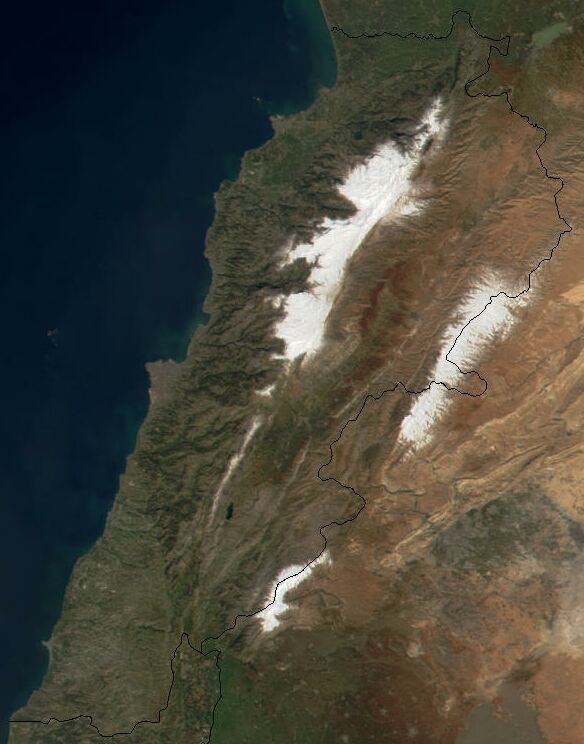 |
Lebanon
is located in Western Asia. It is
bordered by the Mediterranean Sea to the
west along a 225 km coastline, by Syria
to the east and north, and by Israel to
the south. The Lebanon-Syria border
stretches for 375 kilometers (233 mi)
and the Lebanon-Israel border for
79 kilometers (49 mi). The border with
the Israeli-occupied Golan Heights in
Syria is disputed by Lebanon in a small
area called Shebaa Farms, but the border
has been demarcated by the United
Nations.
Most of
Lebanon's area is mountainous terrain,
except for the narrow coastline and the
Beqaa
Valley, which plays an integral role in
Lebanon's agriculture.
Google Satelite view
33°54′N, 35°32′E |
Lebanon from space. Snow cover can be
seen on the western and eastern mountain
ranges
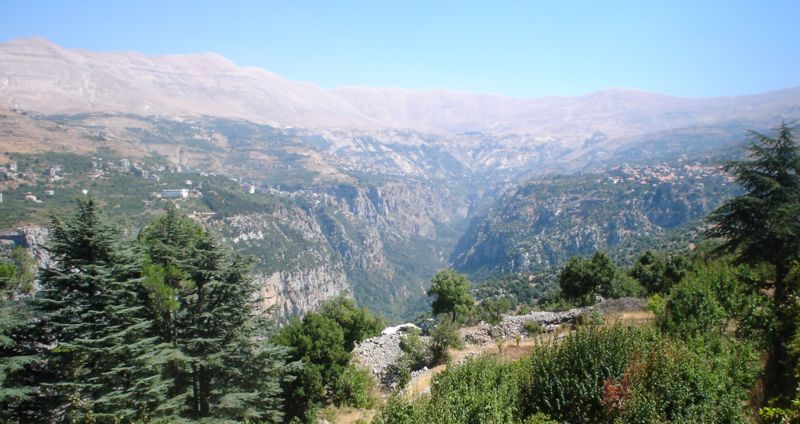
The Kadisha Valley, viewed
from Dimane, Bsharri, Lebanon.
Backed by the Mount Lebanon mountains,
Beirut is situated on a spur where the
narrow coastal plain projects into the
Mediterranean Sea.
Beirut's coast is rather diverse; rocky
beaches, sandy shores, and cliffs are
situated beside one another.
Beirut is
located halfway along the Lebanese
coastline with Byblos and Tripoli to the
North, and Sidon and Tyre to the South.
The Lebanon Mountains surround much of
Beirut, with Eastern Lebanon behind
them. Its location makes it easy to
reach from almost any location in
Lebanon.
In
ancient times, Lebanon housed large
forests of the Cedars of
Lebanon, which now serve as the
country's national emblem. However,
centuries of trading cedar trees, used
by ancient mariners for boats, and the
absence of any efforts to replant them
have depleted Lebanon's once-flourishing
cedar forests.
Climate
Lebanon has a moderate
Mediterranean climate. In coastal areas,
winters are generally cool and rainy
whilst summers are hot and humid. In
more elevated areas, temperatures
usually drop below freezing during the
winter with frequent, sometimes heavy,
snow; summers, on the other hand, are
warm and dry. Although most of Lebanon
receives a relatively large amount of
rainfall annually (compared to its arid
surroundings), certain areas in
north-eastern Lebanon receive little
rainfall because the high peaks of the
western mountain front block much of the
rain clouds that originate over the
Mediterranean Sea.
Beirut
has a
mediterranean
climate characterized by a hot and dry
(but humid) summer, pleasant fall and
spring, and cool, rainy winter. August
is the hottest month of the year with a
monthly average high temperature of 29
°C (85 °F), and January and February are
the coldest months with a monthly
average low temperature of 10 °C (50
°F). During the afternoon and evening,
the wind direction is from the west, the
mediterranean sea direction, towards
inland; at night the wind direction is
reversed, blowing from the land out to
sea.
Winter is
the rainy season, with major
precipitation falling after December.
The average annual rainfall is 860
millimetres (34.1 Inches); the rainfall
is concentrated during scattered days in
winter falling in heavy cloudbursts.
|
Weather averages for Beirut |
| Month |
Jan |
Feb |
Mar |
Apr |
May |
Jun |
Jul |
Aug |
Sep |
Oct |
Nov |
Dec |
Year |
|
Average
high °C (°F) |
16 (61) |
16 (62) |
18 (65) |
21 (71) |
23 (75) |
26 (80) |
28 (84) |
29 (85) |
28 (83) |
26 (80) |
22 (72) |
17 (64) |
22 (73) |
|
Average
low °C (°F) |
10 (50) |
10 (50) |
11 (52) |
14 (58) |
17 (63) |
20 (69) |
22 (73) |
23 (75) |
22 (72) |
20 (68) |
15 (59) |
11 (53) |
16 (62) |
|
Precipitation cm (inch) |
18 (7.4) |
15 (6) |
9 (3.8) |
5 (2.0) |
1 (0.7) |
0.25 (0.1) |
0 (0) |
0 (0) |
0.5 (0.2) |
4 (1.9) |
11 (4.7) |
17 (6.9) |
86 (34.1) |
|
Source:
Weatherbase 2007 |
Education
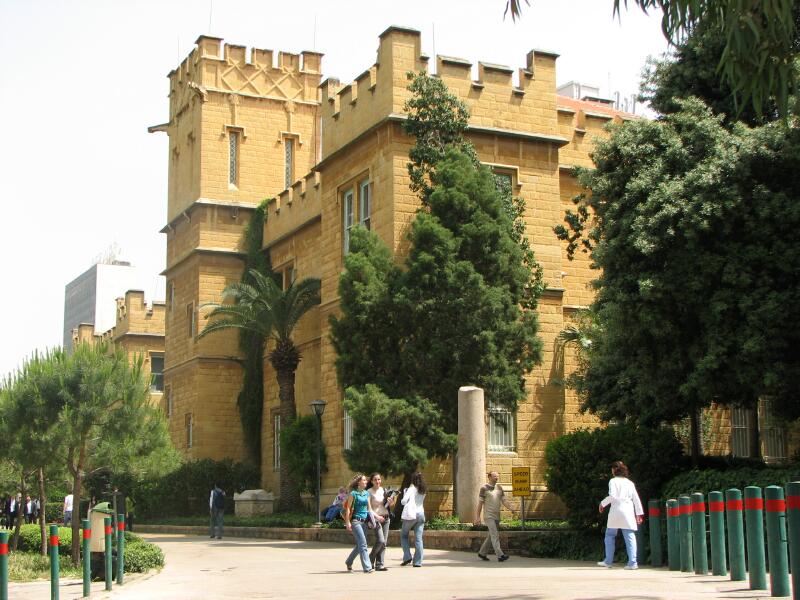 |
Higher education in Beirut, and
all over Lebanon, is provided by
technical and vocational
institutes, university colleges,
university institutes and
universities. Among these
numbers of institutions
nationwide, the
Lebanese
University is the only public
institution in the capital. The
responsibility of the
Directorate General of Higher
Education is responsible for
managing the university
colleges, university Institutes
and Universities in Beirut and
nationwide.
The higher education system is
based on the Baccalauréat
libanais. Before admissing to
any recognizable higher
institution, one much already
conclude his or her Baccalauréat
examinations. Baccalauréat
technique is an alternative to
credentials.
|
The
American University of Beirut
Foreign
students who do wish to study in higher
Lebanese institutions must also meet
Lebanese qualifications. Their
examinations must be equivalent to the
Baccalauréat system before they are
granted admission to higher
institutions. They are not subject to
any special quota system, and
scholarships are granted within the
framework of bilateral agreements
concluded with other countries. Degrees
obtained outside Lebanon must be
certified by the Lebanese embassy abroad
and the Ministry of Foreign Affairs in
Lebanon. Then, candidates must go in
person to the Secretariat of the
Equivalence Committee with required
documents.
Schools
All
Lebanese schools are required by the
government to follow a prescribed
curriculum designed by the Ministry of
Education. Private schools,
approximately 1,400 in all,
may also add more courses to their
curriculum with approval from the
Ministry of Education. The main subjects
taught are mathematics, sciences,
history, civics, geography, Arabic, and
either French or English or both. The
subjects gradually increase in
difficulty and in number. Students in
Grade 11, for example, usually study up
to eighteen different subjects. Arabic
and French are both mandatory and are
taught throughout the 12 year span of
school.
The government
introduces a mild form of selectivity
into the curriculum by giving 11th
graders choice between two
"concentrations": sciences, humanities,
and 12th graders choose
between four concentrations: life
sciences, general sciences, sociology
and economics, and humanities and
literature. The choices in concentration
do not include major changes in the
number of subjects taken (if at all).
However, subjects that fall out of the
concentration are given less weight in
grading and are less rigorous, while
subjects that fall within the
concentration are more challenging and
contribute significantly to the final
grade.
Students go
through three academic phases:
-
- Elementary:
Six years.
-
- Intermediate: Three years;
students earn Intermediate
Certification (Lebanese Brevet)
at completion.
-
- Secondary:
three years, students who pass
official exams earn a Baccalaureate
Certificate (Baccalauréat
Libanais) in the concentration
they chose in 12th grade. Students
studying at French-system schools
may also graduate with a French
Baccalaureate that is considered
equivalent to the Lebanese
Baccalaureate.
These three
phases are provided free to all students
and the first eight years are, by law,
compulsory.
Nevertheless, this requirement currently
falls short of being fully enforced.
Higher
education
Following secondary school, Lebanese
students may choose to study at a
university, a college, or a vocational
training institute. The number of years
to complete each program varies. While
the Lebanese educational system offer a
very high quality and international
class of education, the local employment
market lacks of enough opportunities,
thus encouraging many of the young
educated to travel abroad.
Lebanon has 41
nationally-accredited universities,
several of which are internationally
recognized. The American University of
Beirut (AUB) and the Université
Saint-Joseph (USJ) were the first
Anglophone and the first Francophone
universities to open in Lebanon
respectively. The forty-one
universities, both public and private,
largely operate in French, or English as
these are the most widely used foreign
languages in Lebanon.
At the English
universities, students who have
graduated from an American-style high
school program enter at the freshman
level to earn their baccalaureate
equivalence from the Lebanese Ministry
of Higher Education. This qualifies them
to continue studying at the higher
levels. Such students are required to
have already taken the SAT I and the SAT
II upon applying to college, in lieu of
the official exams. On the other hand,
students who have graduated from a
school that follows the Lebanese
educational system are directly admitted
to the sophomore year. These students
are still required to take the SAT I,
but not the SAT II. The University
academic degrees for the first stage are
the Bachelor or the Licence, for the
second stage are the Master or the DEA
and the third stage is the doctorate.
The United
Nations assigned Lebanon an Education
Index of 0.84 in 2005.
Language
Lebanon's official language is
Arabic per article
11 of the Constitution. Although the law
allows French to be used for some
official purposes, and French is
therefore considered as an
administrative language.
Armenian
and English are also widely spoken and
understood. The majority of Lebanese
people speak Arabic and French fluently.
The colloquial
variant of Arabic used in Lebanon is one
part of a grouping of dialects called
Levantine Arabic, differing in a way
from the literary Modern Standard
Arabic, owing its historical blend to
Arabic, Turkish, and the Syriac dialect
of Aramaic. Lebanese people usually tend
to mix a variant of French when speaking
Arabic. In recent years, it has become
increasingly common for Lebanese people,
especially the better educated, to
converse in a combination of Arabic,
English and French whereby the same
sentence would include words or
expressions from the different
languages.
Regional
influences and occupations throughout
the centuries could possibly explain why
Lebanese people speak so many languages,
even incorporating them into their own.
In addition, due to the importance of
the Lebanese diaspora and business
interests of Lebanese worldwide, it has
always been important to master
languages other than Arabic.
In the
Christian communities, until the
Lebanese Civil War, it was seen as a
mark of status to not speak Arabic.
The reason for this could possibly be
that Christians generally were educated
in many of the French educational
institutions and so a general
Francophonic class emerged in their
communities. English has been making
significant headway in the past two
decades. However, as the Muslim
population increased in previously
Christian areas, Arabic in public is
omnipresent, not merely commonplace.[citation
needed]
Transportation
The
city's airport is the Beirut
Rafic Hariri International Airport and
is located in the southern suburbs.
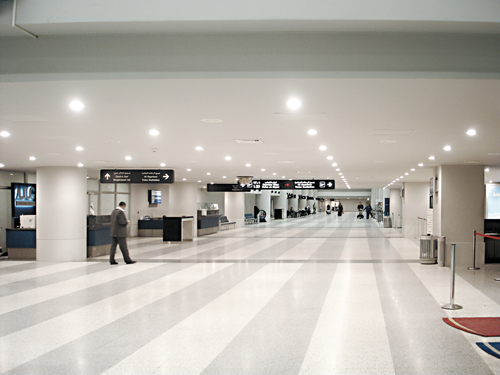 |
By land,
the latter are served by either
service or taxis. Service is a
lot cheaper than taxis however,
to avoid misunderstanding,
agreement over the pricing need
to be made before setting off.
Beirut has
frequent bus connections to
other cities in Lebanon and
major cities in Syria. The
Lebanese Commuting Company, or
LCC in short, is just one of a
handful brands of public
transportations all over
Lebanon. On the other hand, the
publicly owned buses are managed
by le Office des Chemins de Fer
et des Transports en Commun (OCFTC),
or the "Railway and Public
Transportation Authority" in
English. Buses for northern
destinations and Syria leave
from Charles Helou Station.
Apart from the
international airport, the Port of
Beirut is another port of entry. As a
final destination, anyone can also reach
Lebanon by ferry from Cyprus or by road
from Damascus.
|
Beirut
airport
Culture
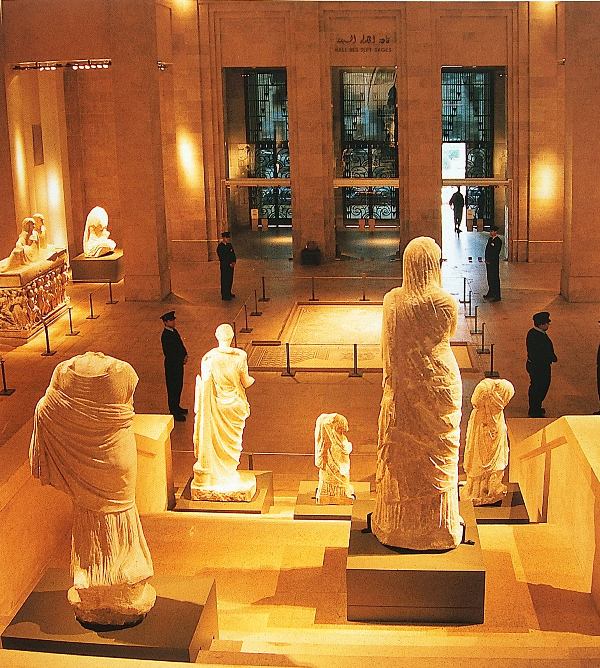 |
Beirut has
been exposed to cultural changes
due to contact with so many
civilizations. As mentioned
under the history of Beirut,
this city had interacted with
cultures from the Greeks to the
Romans and, presently, to the
Arabs. Not only was there a law
school under the Romanized
Berytus, it was also believed to
be the first law school in the
world. Because of this, this is
currently part of the cultural
pride of the Lebanese.
The national museum is situated
in Beirut. The National Museum
of Beirut is just a few blocks
from the French Embassy and the
Military Tribunal, and it is
founded just at the corner of
the Damascus Expressway. Apart
from this, however, there is a
more private museum within the
courtyards of the American
University of Beirut, the third
oldest museum in the Middle
East.
|
The National Museum of
Beirut
Despite Beirut
dating back over 5000 it is only
recently that ruins have been
discovered, the finds are from numerous
civilizations: Canaanite, Phoenician,
Hellenistic, Roman and Ottoman. The
architecture in Beirut reflects the
varied influences from different
religions to different civilizations.
Since the civil war massive regeneration
has happened to Beirut, most visibly the
Beirut Central District (BCD) which was
completed in 2001
.
The area
including modern Lebanon has been home
to various civilizations and cultures
for thousands of years. Originally home
to the
Phoenicians, and then subsequently
conquered and occupied by the Assyrians,
the Persians, the Greeks, the Romans,
the Arabs, the Ottoman Turks and most
recently the French, Lebanese culture
has over the millennia evolved by
borrowing from all of these groups.
Lebanon's diverse population, composed
of different ethnic and religious
groups, has further contributed to the
country's lively festivals, highly
successful musical styles and literature
as well as their rich cuisine, and
numerous violent clashes amongst
different religious and ethnic groups.
When compared to the rest of the Western
Asia, Lebanese society as a whole is
well educated, and as of 2003 87.4% of
the population was literate. Lebanese
society is very modern and similar to
certain cultures of Mediterranean
Europe. It is often considered to serve
as the European gateway to Western Asia
as well as the Arab gateway to the
Western World.
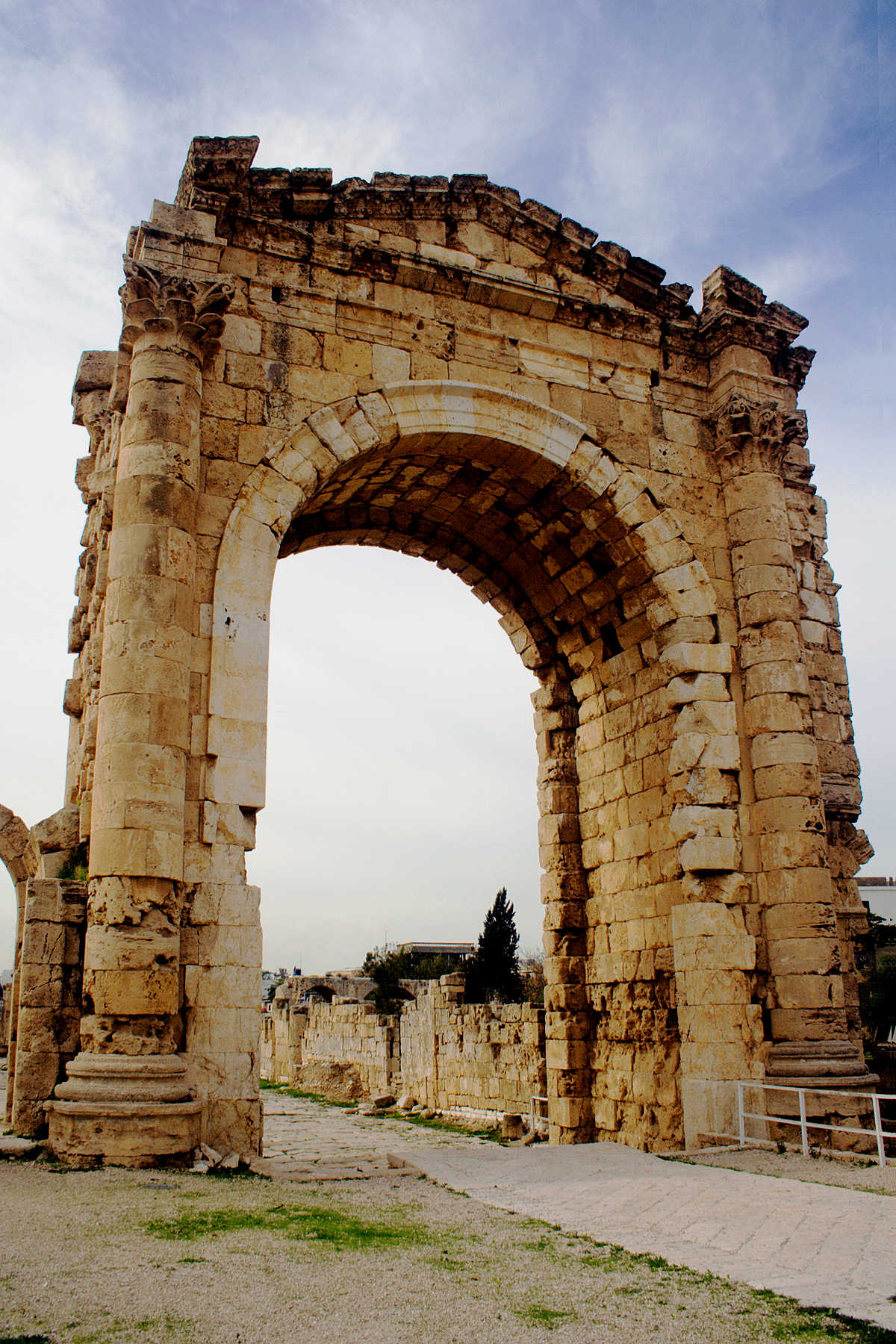 |
 |
The Triumphal Arch in Tyre.
Phoenicia and its colonies.
Media
Beirut is the main center in Lebanon for
the television, newspaper, and book
publishing industries. The television
stations include
Tele Liban:
Télé Liban
is
Lebanese
television network, owned by the
Lebanese government. It mainly
broadcasts terrestrially throughout
Lebanon. TL is the current Lebanese
member of the European Broadcasting
Union. Radio Liban, the government
operated radio station, was one of the
23 founding broadcasting organisations
of the EBU but ceased to be a member in
2002. Radio Liban is today a part of
Radio France Internationale.
LBC:
The
Lebanese Broadcasting
Corporation,
widely known as LBC, is the first
private television station in
Lebanon. It went global in 1996 when it
launched its satellite channel LBC
covering the Middle East. It now has
several channels covering Europe, North
America,Australia, and Africa.
Future TV:
Future Television
is a television station broadcasting
from
Lebanon.
It was was founded in 1993 by the late
Rafik Hariri, a former Prime Minister of
Lebanon. Future TV is also available via
satellite in Europe, the United States,
Canada, and Australia. Politically, the
channel supports the views of the Future
Movement.
Future
International grew to become one of the
leading Arab satellite stations
gathering the highest audience ratings
in the Gulf, Egypt and the Levant. Ever
since, Future International has been an
24 hour open window to Lebanon for the
Arab world, North Africa, and South
Europe. Like Future Television, Future
International is a family TV that
promotes Lebanon as a place for
reconstruction, civilization,
prosperity, coexistence, fun and good
times.
New
TV:
Usually
short-handed NewTV. New TV is a
24-hour PAN Arab station broadcasting
from Lebanon offering genera-interest
programming in the Arabic language. The
launch of New TV took place on October
4, 2001 in Lebanon and the Arabic
Countries. On May 9, 2005 New TV Sat was
launched in America and the Pacific,
reaching Arab speaking emigrants in the
United States, South America and
Australia.
Al-Manar:
Is
the satellite television station of
Hezbollah, broadcasting from Beirut,
Lebanon and offering a "rich menu" of
high production news, commentary, and
entertainment in the service of what
Hezbollah believes is Islamic unity and
resistance. The self-proclaimed "Station
of the Resistance" (qanat al-muqawama),
is a key player in what Hezbollah calls
its "psychological warfare against the
Zionist enemy" and an integral part of
Hezbollah's plan to spread its message
to the entire Arab world. i.e. the state
of Israel. Currently, programming is
geared towards coverage of the
Palestinian cause, and the U.S.
coalition's occupation of Iraq,
encouraging resistance against American
and Israel, and elimination of the
Zionist entity.
Al-Manar was
designated a 'terrorist entity', and
banned by the United States in December
2004. It has also been banned by France
and Spain, and has run into some service
and license problems abroad, making it
unavailable in the Netherlands, south
America, Canada and Australia while it
has not officially been banned in any of
these regions.
The station was
launched by Hezbollah in 1991 with the
help of Iranian funds, by 2004, Al Manar
was estimated to hold 10-15 million
viewers daily worldwide. Critics claim
al-Manar's agenda is influenced by Iran
by virtue of the "significant portion"
of Hizbollah's budget shortfall that is
covered by Iran, via some of the "$100
and $200 million a year" Iran provides
to Hezbollah itself. Al-Manar officials
strongly deny this, saying they are
subsidized by the Hezbollah party and
donations from other Muslims, not by
Iran.
ANB, NBN
, and
OTV:
Is a publicly-traded television station
in
Lebanon.
Affiliated with the Free Patriotic
Movement though not officially, it
started broadcasting on July 20, 2007 on
the Arabsat-BADR 3 satellite. It now
also broadcasts on NILESAT and in North
America on Satellite Galaxy 25, and also
in Australia on Satellite:Inelsat 8.
It is the first
time in Lebanon,
that a Television station is a
publicly-traded company.
The
newspapers include
An-Nahar,
As-Safir, Al Mustaqbal,
Al
Akhbar,
Al-Balad,
Ad-Diyar, Al Anwar, Al Sharq,
L'Orient, Le Jour and the
Daily Star.
Religion
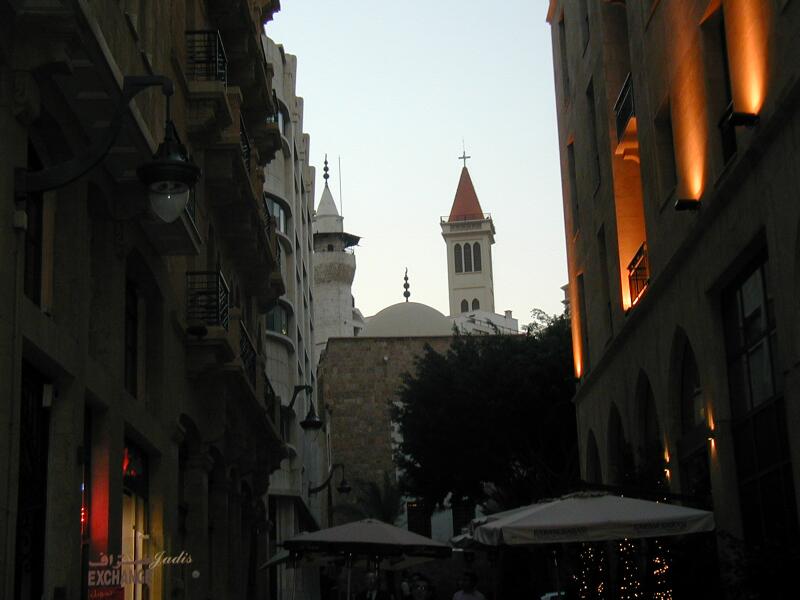 |
Beirut is one of the most
religiously diverse cities of
the Middle East, with
Christians, Muslims, and
atheists all having a
significant presence. Beirut is
the most Christian capital of
the Middle East. There are nine
major religious sects in Beirut
(Sunni Muslim, Shiite Muslim,
Druze, Maronite Catholic, Greek
Orthodox, Greek Catholic,
Armenian Orthodox, Armenian
Catholic, and Protestant).
Family matters such as marriage,
divorce and inheritance are
still handled by the religious
authorities representing a
person's faith. Calls for civil
marriage are unanimously
rejected by the religious
authorities but civil marriages
held in another country are
recognized by Lebanese civil
authorities.
Beirut
has had a history of political
strife due to religious
divisions. Religion has
historically divided Lebanese
society decisively, evident in
its prolonged civil war.
|
Mosque and Church in
Downtown Beirut
Lebanon’s primary religious groups, very
roughly, are
Shia Muslim (the
largest group), Sunni Muslim, Christian,
and Druze. Muslims represent roughly 60%
of the total population, while
Christians make up the other 40%. Of the
Muslims, the predominant Shi'a make up
60%, while the Sunni make up most of the
remainder. Druze and Alawis are
minorities.
The
division of power between the religious
groups is an interesting problem. The
Lebanese have solved this by making
different high ranking government
positions represented by the different
religious groups, as per the Taif accord
(1989). The President must be Marounite,
the Prime Minister must be Sunni, and
the Speaker of the Parliament must be
Shi'a. The patron saint of Lebanon is
St. Charbel.
Economy
The
urban population in Lebanon is noted for
its commercial enterprise.
Over the course of time, emigration has
yielded Lebanese "commercial networks"
throughout the world. Lebanon has a high
proportion of skilled labour comparable
to most European nations and the highest
among Arabic speaking countries.
Although
Lebanon is ideally suited for
agricultural activities in terms of
water availability and soil fertility,
as it possesses the highest proportion
of cultivable land in the Arabic
speaking world, it does not have a large
agricultural sector. Attracting a mere
12% of the total workforce, agriculture
is the least popular economic sector in
Lebanon. It contributes approximately
11.7% of the country's GDP, also placing
it in the lowest rank compared to other
economic sectors. Major produce include
apples, peaches, oranges, and lemons.
Lebanon's lack
of raw materials for industry and its
complete dependency on Arab countries
for oil have made it difficult for the
Lebanese to engage in significant
industrial activity. As such, industry
in Lebanon is mainly limited to small
businesses concerned with reassembling
and packaging imported parts. In 2004,
industry ranked second in workforce,
with 26% of the Lebanese working
population, and second in GDP
contribution, with 21% of Lebanon's GDP.
A combination
of beautiful climate, many historic
landmarks and World Heritage Sites
continues to attract large numbers of
tourists to Lebanon annually, in spite
of its political instability. In
addition, Lebanon's strict financial
secrecy and capitalist economy—unique in
its area—have given it significant
economic status among Arab countries.
The thriving tourism and banking
activities have naturally made the
services sector the most important
pillar of the Lebanese economy. The
majority of the Lebanese workforce
(nearly 65%) have preferred employment
in the services sector, as a result of
the abundant job opportunities and large
paychecks. The GDP contribution,
accordingly, is very large and amounts
to roughly 67.3% of the annual Lebanese
GDP.
The economy's
dependence on services has always been
an issue of great criticism and concern,
as it leaves the country subject to the
instability of this sector and the
vagaries of international trade.
The 1975-1990
civil war seriously damaged Lebanon's
economic infrastructure, cut national
output by half, and all but ended
Lebanon's position as a West Asian
entrepôt and banking hub. The subsequent
period of relative peace enabled the
central government to restore control in
Beirut, begin collecting taxes, and
regain access to key port and government
facilities. Economic recovery has been
helped by a financially sound banking
system and resilient small- and
medium-scale manufacturers, with family
remittances, banking services,
manufactured and farm exports, and
international aid as the main sources of
foreign exchange.
Until the 2006
Lebanon War, Lebanon's economy witnessed
excellent growth, with bank assets
reaching over 75 billion dollars. By the
end of the first half of 2006, the
influx of tourists to Lebanon had
already registered a 49.3% increase over
2005 figures. Market capitalization was
also at an all time high, estimated at
$10.9 billion at the end of the second
quarter of 2006, just weeks before the
fighting started.
Beirut's
airport, Rafiq Hariri International
Airport, re-opened in September 2006 and
the efforts to revive the Lebanese
economy have since been proceeding at a
slow pace. Major contributors to the
reconstruction of Lebanon include Saudi
Arabia (with $US 1.5 billion pledged),
the European Union (with about $1
billion) and a few other Gulf countries
with contributions of up to $800
million.
Cuisine
The Lebanese
Cuisine is considered to be a
Mediterranean basically Levantine Arabic
delicacy consisting of a variety of
fresh vegetarian recipes, salads and
stews all seasoned with a flavorsome
combination of herbs and spices. One of
the most world known Lebanese
specialties is called the Maza, also
written "Mezze", which is a selection of
appetisers: olives, cheeses, Labanee, or
small portions also known as
muqabbilat (Arabic for starters).
As with most
Mediterranean cuisines, Lebanese cuisine
is considered to be a very balanced,
healthy diet.
The cuisine of
Lebanon is the epitome of the
Mediterranean diet. It includes an
abundance of starches, fruits,
vegetables, fresh fish and seafood;
animal fats are consumed sparingly.
Poultry is eaten more often than red
meat, and when red meat is eaten it is
usually lamb. It also includes copious
amounts of garlic and olive oil-nary a
meal goes by in Lebanon that does not
include these two ingredients. Most
often foods are either grilled, baked or
sauted in olive oil; butter or cream is
rarely used other than in a few
desserts. Vegetables are often eaten raw
or pickled as well as cooked. While the
cuisine of Lebanon doesn't boast an
entire repertoire of sauces, it focuses
on herbs, spices and the freshness of
ingredients; the assortment of dishes
and combinations are almost limitless.
The meals are full of robust, earthy
flavors and, like most Mediterranean
countries, much of what the Lebanese eat
is dictated by the seasons.
Food and
music overlap greatly with those of
Syria, Palestine, Egypt, Greece, and
Turkey (all were Ottoman provinces for
400 years.)
Ceative arts
Lebanese music is known around the world
for its soothing rhythms and oriental
beats. Traditional and folk music are
extremely popular as are western
rhythms.
One of the most
well-known Lebanese singers is Fairuz;
her songs are broadcast every morning on
most radio stations and many TV
channels, both in Lebanon and the Arab
world in general.
Wadi Al Safi
(born Wadih Francis in Niha,
Lebanon) is a Lebanese singer,
songwriter, and actor. He is a Lebanese
cultural icon, and is often called the
"Voice of Lebanon".
Other prominent
artists include Julia Boutros, composer
and oud player Marcel Khalife, Majida El
Roumi, and Sabah.
Some Lebanese
artists, such as Najwa Karam and Assi
Hellani, remain loyal to a traditional
type of music known as 'jabali' ("from
the mountains"), while other artists
incorporate Western style into their
songs. Lebanese artists are perhaps the
most popular in the Arab world,
alongside Egyptian performers, and the
star scene includes prominent figures
like Najwa Karam, Nancy Ajram, Elissa
(singer), Ragheb Alame, Myriam Fares,
Wael Kfoury, Nawal al Zoghbi, Haifa
Wehbe, Carole Samaha, Julia Boutros,
Marwan Khouri, Waleed Tawfeek, Amal
Hijazi and Majida El Roumi.
Arts & Fashion
There
are hundreds of art galleries in Beirut
and its suburbs. Lebanese people are
very involved in art and art production.
More than 5000 fine art artists and
equal artists working in music, design,
architecture, theatre, movie industry,
photography and all other forms of art
are producing in Lebanon. Every year
hundreds of fine art students graduate
from universities and institutions.
Artist Workshops are flourishing all
around Lebanon. In Beirut specifically,
the art scene is very rich, vibrant and
diverse.
On
another scale, fashion and couture are
very much thriving throughout the city.
Fashion houses are opening up and a
number of international fashion
designers have displayed their work in
various fashion shows. Beirut is also
home to international fashion designers
such as Elie Saab, Zuhair Murad, and
Georges Chakra.
Sports
Because of Lebanon's unique geography,
both summer and winter sports thrive in
the country. In fact, in autumn and
spring it is sometimes possible to
engage in both during the same, skiing
in the morning and swimming in the
Mediterranean
during the afternoon. At the competitive
level, basketball, football are among
Lebanon's most popular sports. In recent
years, Lebanon has hosted the Asian Cup
and the Pan-Arab Games; the country will
host the Winter Asian Games in 2009. To
meet the needs of these international
competitions, Lebanon maintains
state-of-the-art athletic facilities,
which in turn encourage local sporting
activities. Lebanon sends athletes to
both the winter and summer games of the
Olympics and Special Olympics. The
Lebanese national soccer team has
progressed past the first round of
qualifying for the FIFA World Cup 2010
by eliminating India, 6-3 on aggregate.
Rugby league is also popular in Lebanon.
The national rugby league team nearly
qualified for the 2008 World Cup, but
were narrowly beaten by Samoa in their
final game.
 |
Lebanon boasts six ski resorts,
with slopes suitable for skiers
and snowboarders of all ages and
levels of experience. Off-slope,
there are many opportunities for
cross-country skiing,
snowshoeing, and snowmobiling.
In the summer, skilifts can be
used to access some of Lebanon's
best hiking trails, with
panoramic views stretching as
far as Cyprus to the west and
Syria to the east on clear days.
Canoeing, cycling, rafting,
climbing, swimming, sailing and
spelunking are among the other
common leisure sports in
Lebanon.
Adventure and extreme sports are
also possible throughout the
country. The Beirut Marathon is
held every fall, drawing top
runners from Lebanon and abroad.
Shorter races are also held for
youth and less serious
competitors. Race day is
promoted as a fun, family event,
and it has become a tradition
for many to participate in
costumes or outlandish clothing. |
Opening
ceremony of the 2000 AFC
Asian Cup in
Camille Chamoun Sports City
Stadium
Beirut, in
addition to Sidon and Tripoli, hosted
the 2000 AFC Asian Cup. There are two
stadiums in the city, Camille Chamoun
Sports City Stadium and Beirut Municipal
Stadium.
There are seven
football teams in the Lebanese Premier
League that are based in Beirut: Nejmeh,
Al-Ansar, Al-Hikma, Al Ahed, Al-Mabarrah,
Safa and Shabab Al-Sahel.
Beirut has two
Basketball teams, Al Riyadi and Al Hikma,
that participate in the premiere
division of the Lebanese Basketball
Championship.
Other sports
events in Beirut include the annual
Beirut Marathon, a weekly Horse racing
at Beirut Hippodrome, and Golf and
Tennis tournaments that take place at
Golf Club of Lebanon.
Recently Beirut
has taken to rugby league as well, with
three out of the five teams in the
Lebanon Championship
based in Beirut.
Arts and
literature
Lebanon's contribution to the Arab
Rennaissance during the middle of the
19th century is immense. This flowering
allowed for the modernisation of the
Arabic language moving it away from its
Koranic classical dictums, and allowing
for the creation and adaptation of
previously unknown terms/ words as Al-Watan
(the nation), Al-Watania (Nationalism).
The first
theatre production in the Arab world was
performed at the Al-Kahzen household in
1862, a Lebanese aristocratic family who
were also representatives of France.
By the
turn of the 20th century, Beirut was
vying with Cairo as the major centre for
modern Arab thought, with untold number
of newspapers, magazines, and literary
societies.
In
literature, Gibran Khalil
Gibran is known to be one of
the world's famous writers,
particularly known for his
book
The Prophet,
which has been translated
into more than twenty
different languages.
Khalil
Gibran (full name Gibran Khalil
Gibran bin Mikhael bin Saâd,(January
6, 1883 – April 10, 1931) was a Lebanese
American artist, poet and writer. He was
born in Lebanon (at the time the Mount
Lebanon Province of the Ottoman Empire)
and spent most of his life in the United
States. He is the third bestselling poet
in history after Shakespeare and Lao Tse.
Several
contemporary Lebanese writers have
achieved international success;
including Elias Khoury, Amin Maalouf and
Hanan al-Shaykh.
In art,
Moustafa Farroukh and Alfred Bassbouss
are very famous. Mustafa Farroukh
(1901-1957) was one of Lebanon's most
prominent painters of the 20th century.
Formally trained in Rome and Paris, he
exhibited in venues from Paris to New
York to Beirut over his career. His work
was applauded for its representation of
real life in Lebanon in pictures of the
country, its people and its customs.
Farroukh became highly regarded as a
Lebanese nationalist painter at a time
when Lebanon was asserting its political
independence. His art captured the
spirit and character of the Lebanese
people and he became recognized as the
outstanding Lebanese painter of his
generation. His total paintings were
more than 2000 sold to collectors inside
and outside of Lebanon. He also wrote
five books and taught art at the
American University of Beirut.
Festivals
|
Several international
music festivals are held
in Lebanon, featuring
world-renowned artists
and drawing crowds from
Lebanon and abroad.
Among the most famous
are Baalbeck
International Festival,
Beiteddine Festival,
Byblos International
Festival, and the Al-Bustan
Festival. Beirut in
particular has a very
vibrant arts scene, with
numerous performances,
exhibits, fashion shows,
and concerts held
throughout the year in
its galleries, museums,
theatres, and public
spaces. |
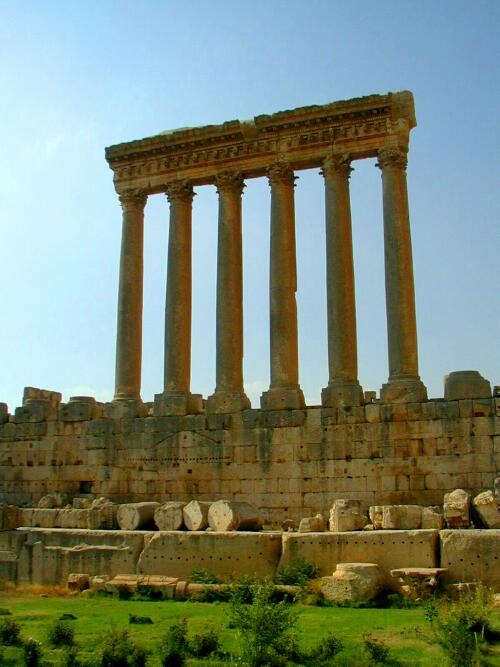 |
Beiteddine Palace, the venue of
Beiteddine Festival.
Temple of Jupiter in Baalbek
Politics
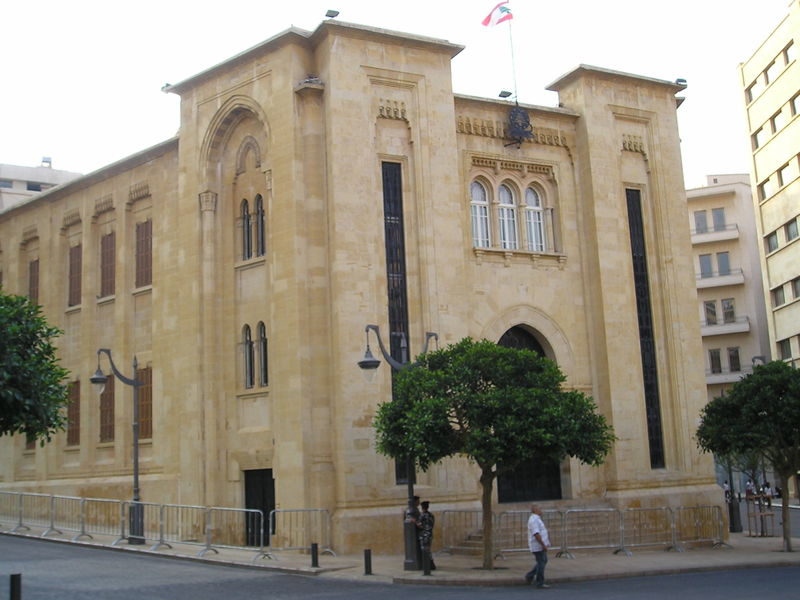 |
Lebanon is a parliamentary,
democratic republic, which
implements a special system
known as confessionalism. This
system, allegedly meant to
insure that sectarian conflict
is kept at bay, attempts to
fairly represent the demographic
distribution of religious sects
in the governing body. As such,
high-ranking offices in the
government are reserved for
members of specific religious
groups. The President, for
example, has to be a Maronite
Catholic Christian, the Speaker
of the Parliament a Shi’a
Muslim, the Prime Minister a
Sunni Muslim and the Deputy
Prime Minister an Orthodox
Christian.
This trend continues in the
distribution of the 128
parliamentary seats, which
are divided equally between
Muslims and Christians.
Prior to 1990, the ratio
stood at 6:5 in favor of
Christians; however, the
Taif Accord, which put an
end to the 1975-1990 civil
war, adjusted the ratio to
grant equal representation
to followers of the two
religions. |
The
Lebanese
parliament building at the
Place de l'Étoile
According to the constitution, direct
elections must be held for the
parliament every four years, although
for much of Lebanon’s recent history,
civil war precluded the exercise of this
right.
The parliament
elects the president for a non-renewable
six-year term. At the urging of the
Syrian government, this constitutional
rule has been bypassed by ad hoc
amendment twice in recent history. Elias
Hrawi’s term, which was due to end in
1995, was extended for three years. This
procedure, denounced by pro-democracy
campaigners, was repeated in 2004 to
allow Émile Lahoud to remain in office
until 2007.
The President
appoints the Prime Minister on the
nomination of the parliament (which is,
in most cases, binding). Following
consultations with the parliament and
the President, the Prime Minister forms
the Cabinet ,
which must also adhere to the sectarian
distribution set out by confessionalism.
The
Grand
Serail, the government
headquarters in downtown
Beirut
Lebanon's
judicial system is based on the
Napoleonic Code. Juries are not used in
trials. The Lebanese court system
consists of three levels: courts of
first instance, courts of appeal, and
the court of cassation. There also is a
system of religious courts having
jurisdiction over personal status
matters within their own communities,
with rules on matters such as marriage,
divorce, and inheritance. Lebanese law
does not provide for Civil marriage
(although it recognizes such marriages
contracted abroad); efforts by former
President Elias Hrawi to legalize civil
marriage in the late 1990s floundered on
objections mostly from Muslim clerics.
Additionally, Lebanon has a system of
military courts that also has
jurisdiction over civilians for crimes
of espionage, treason, and other crimes
that are considered to be
security-related. These military courts
have been criticized by human rights
organizations such as Amnesty
International for "seriously fall[ing]
short of international standards for
fair trial" and having "very wide
jurisdiction over civilians".
After Rafic
Hariri's assassination on 14 February
2005, the country has seen turbulent
political times, and it shaped the Cedar
Revolution and the rise of the March 14
alliance which is made of: Lebanese
Forces, Future Movement and the PSP.
|
Copyright © 2008 www.kaloustian.nl -
www.kaloustian.eu. All Rights Reserved. |
|
